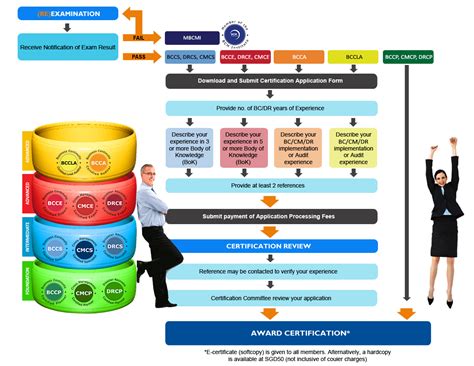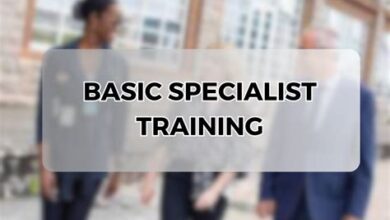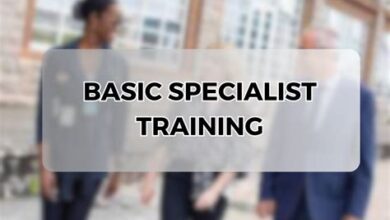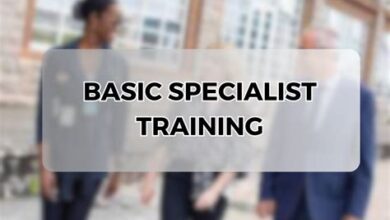Step-By-Step Process Of Basic Specialist Training

Discover the significance of basic specialist training, learn to assess training needs, develop effective curricula, implement practical sessions, and evaluate program outcomes. In today’s rapidly evolving professional landscape, the significance of specialized training cannot be overstated.
Whether you are looking to enhance employee skills or propel your organization’s competitiveness, understanding the step-by-step process of Basic Specialist Training is crucial. This guide will walk you through everything from assessing training needs and developing an effective curriculum, to implementing practical sessions and evaluating the outcomes.
With a structured approach, organizations can better equip their teams with the necessary expertise to excel in their roles. Join us as we delve into the essential components of effective specialist training that can lead to improved performance and success in your field.
Understanding The Importance Of Basic Specialist Training
Basic Specialist Training is a critical component in the professional development of individuals aiming to excel in their fields. This training provides foundational skills, knowledge, and practical experience that are essential for specialized roles. By focusing on the Step-By-Step Process of training, organizations can ensure that their workforce is adequately prepared to meet the demands of the industry.
One of the primary reasons for investing in Basic Specialist Training is to enhance competency and performance. Employees who undergo systematic training are better equipped to handle job responsibilities, leading to increased efficiency and productivity. Furthermore, specialized training fosters a culture of continuous learning within organizations, encouraging employees to stay updated with the latest developments in their respective fields.
Another key aspect of Basic Specialist Training is its role in improving job satisfaction and retention rates. When employees feel competent and supported through their training, they are more likely to stay committed to their organization. This commitment translates into lower turnover rates, which ultimately benefits the company by preserving institutional knowledge and reducing recruitment costs.
Moreover, Basic Specialist Training emphasizes the importance of standardized skills among employees. With a structured training program, organizations can ensure that their staff possesses the necessary qualifications and understands best practices in their roles. This uniformity not only improves quality but also enhances collaboration among team members, as everyone is on the same page regarding processes and expectations.
The importance of Basic Specialist Training cannot be overstated. It lays the groundwork for effective workforce capabilities, fosters a culture of growth, and contributes to overall organizational success. By implementing a well-defined Step-By-Step Process for training, companies can maximize the potential of their employees and ensure a skilled, dedicated workforce ready to tackle future challenges.
Step-By-Step Process To Assess Training Needs
Assessing the training needs is a crucial part of developing a successful Basic Specialist Training program. It ensures that the training provided is tailored to meet the specific requirements of the participants, ultimately leading to improved outcomes. Here’s a step-by-step process to effectively assess training needs:

- Identify Organizational Objectives: Begin by reviewing the organization’s goals and objectives. Understanding these will help align the training needs with strategic priorities.
- Engage Stakeholders: Involve key stakeholders, including management, team leaders, and employees. Conduct interviews or focus groups to gather insights into perceived gaps in skills and knowledge.
- Conduct a Skills Gap Analysis: Evaluate current employee competencies against the required performance levels. This can be achieved through surveys, assessments, and performance reviews.
- Analyze Training Resources: Assess available resources, including time, budget, and training materials. This evaluation will help you determine what can be realistically implemented.
- Determine Learning Preferences: Understanding how employees prefer to learn (e.g., in-person, online, hands-on) will enable you to tailor the training methods to their needs.
- Set Training Objectives: Based on the analysis, clearly define what the training should achieve. Objectives should be specific, measurable, achievable, relevant, and time-bound (SMART).
- Prioritize Training Needs: Rank the identified training needs in order of importance and urgency. This helps in allocating resources effectively and creating a focused training agenda.
- Develop an Action Plan: Create a detailed action plan that outlines the steps required to address the training needs, including timelines and responsible parties.
- Review and Revise: Regularly revisit the training needs assessment process to ensure it remains relevant and adjusts to changes in organizational goals or staff capabilities.
By following this step-by-step process, organizations can ensure that their Basic Specialist Training programs are effective, targeted, and yield measurable results that benefit both the participants and the organization as a whole.
Developing A Curriculum For Effective Specialist Training
Developing a curriculum for effective specialist training is a critical component that ensures the training program meets the necessary standards and fulfills the learning requirements of participants. A well-structured curriculum not only enhances the learning experience but also equips trainees with the essential skills and knowledge they need. Here’s a step-by-step process to guide you in developing an effective curriculum:

- Identify Training Objectives: Start with a clear understanding of what the training aims to achieve. Outline the specific skills and knowledge areas that the curriculum should address. This step is essential to create a focused and relevant training program.
- Assess Learner Needs: Engage with potential participants and stakeholders to gather insights about their knowledge gaps and expectations. This will help you tailor the curriculum to suit the learners’ needs.
- Outline Course Content: Organize the training topics logically, ensuring that they flow in a coherent manner. Break down the information into modules or units that cover different aspects of the specialist training.
- Select Instructional Methods: Choose teaching methods that best fit the content and the learning preferences of the trainees. This could include lectures, practical exercises, case studies, or group discussions.
- Incorporate Assessments: Plan for assessments that will help evaluate the learners’ understanding and skills. Use a mix of formative (ongoing) and summative (final) assessments to measure progress throughout the training.
- Allocate Resources: Identify and secure the necessary resources—such as training materials, tools, and facilities—that will support the curriculum effectively.
- Review and Revise: After drafting the curriculum, seek feedback from peers or experts in the field. Make necessary revisions based on their input to ensure that the curriculum is robust and effective.
- Implement Pilot Testing: Once the curriculum is finalized, consider conducting a pilot session with a small group to test the effectiveness of the content and delivery methods. Use the feedback obtained to make further adjustments.
- Document the Curriculum: Create a comprehensive document outlining the curriculum, including objectives, content, instructional methods, and assessment strategies. This documentation serves as a valuable resource for trainers and future course iterations.
- Monitor and Evaluate: After implementation, regularly monitor the effectiveness of the training through evaluations and feedback from participants. This ongoing assessment allows for continuous improvement of the curriculum, ensuring it remains relevant and effective.
By following this step-by-step process, you can develop a curriculum that not only meets the objectives of the specialist training but also maximizes the impact on your trainees’ learning journey.
Implementing Training Through Practical Sessions
Implementing training through practical sessions is a crucial aspect of the Step-By-Step Process of Basic Specialist Training. This approach not only enhances theoretical knowledge but also allows trainees to apply what they have learned in a real-world context. Here are key considerations for ensuring effective practical training:
- Hands-On Experience: Engaging participants in hands-on activities helps solidify their understanding. Incorporating simulations, role plays, or case studies can provide valuable experience.
- Real-World Scenarios: Use actual case studies and scenarios that specialists might encounter. This transition from theory to practice allows trainees to develop critical thinking and problem-solving skills.
- Feedback Mechanisms: Establishing a feedback loop during practical sessions encourages growth. Regular evaluations and constructive criticism can enhance learning outcomes.
- Role of Mentors: Assigning experienced mentors to guide trainees during practical sessions supports skill development and increases confidence.
- Environment Setup: Ensure that the training environment mimics real-life situations as closely as possible. This can include using specialized tools, equipment, or software that specialists use in their daily tasks.
By incorporating these elements into the training session, organizations can ensure participants are well-prepared to handle their responsibilities post-training. The practical application of knowledge makes the learning experience memorable and impactful, aligning with the overall goals of the Step-By-Step Process.

Evaluating The Results Of Specialist Training Programs
Evaluating the results of specialist training programs is a crucial step in ensuring that the training objectives are met and to identify areas for improvement. A structured approach enhances the effectiveness of the training and informs future developments. Here’s a step-by-step breakdown of how to evaluate the outcomes effectively:
1. Define Clear Objectives: Before the training begins, it’s essential to establish clear, measurable objectives. These objectives will serve as benchmarks against which the training results can be assessed.
2. Use Multiple Evaluation Methods: Implement various evaluation methods to gain comprehensive insights. This can include surveys, interviews, practical assessments, and performance metrics. For example, using both subjective (surveys) and objective measures (test scores) can provide a balanced view of training effectiveness.
3. Analyze Feedback: Gather feedback from participants regarding the training experience. Understanding their perspectives can highlight strengths and weaknesses in the program. Encourage open dialogue during this stage to identify any gaps that may require attention.
4. Measure Performance Improvements: Assess participants’ performance before and after the training. This can be done through direct observation, performance reviews, or by tracking key performance indicators (KPIs) related to their roles.
5. Consider Long-Term Impact: Evaluate the long-term effects of the training on job performance and career progression. This assessment can often take place several months after training to fully understand its impact.
6. Integrate Feedback into Future Training: Use the insights gained from the evaluation process to refine and improve future training programs. This ensures that the training remains relevant and effective in meeting the evolving needs of the organization and its staff.
By following this step-by-step process, organizations can effectively assess the results of their specialist training programs, thus ensuring their investment in training yields the desired return.
Frequently Asked Questions
What is Basic Specialist Training?
Basic Specialist Training is a systematic program designed to equip healthcare professionals with the fundamental skills and knowledge required for their specialty discipline.
What are the initial steps to begin Basic Specialist Training?
The initial steps typically include obtaining a relevant degree, completing any necessary prerequisites, and applying directly to a training program or institution.
How long does Basic Specialist Training usually last?
The duration of Basic Specialist Training can vary, but it generally lasts between one to three years, depending on the specific specialty and training requirements.
What types of specialties can be pursued during Basic Specialist Training?
Basic Specialist Training can cover a wide range of medical fields, including but not limited to surgery, internal medicine, pediatrics, and anesthesiology.
Are there assessments during Basic Specialist Training?
Yes, assessments are a crucial part of Basic Specialist Training and may include practical exams, written tests, and regular evaluations to measure a trainee’s progress.
What support is available for trainees during this training process?
Trainees typically have access to mentorship, educational resources, peer support groups, and scheduled feedback sessions to help them navigate their training effectively.
What are the common challenges faced during Basic Specialist Training?
Common challenges can include time management, high-pressure environments, balancing practical experience with theoretical knowledge, and coping with the emotional demands of the medical field.





